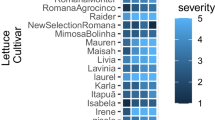Summary
Long-day-adaptedSolanum phureja clones were assessed for resistance to blackleg caused byErwinia carotovora subsp.atroseptica under field and controlled environmental conditions over two years. In the field, twenty-two of the twenty-three clones ofS. phureja assessed were as resistant to blackleg as the commercial cultivar Ailsa, the most resistant control, and were significantly (P<0.001) more resistant than the intermediate and susceptible cultivars Wilja and Estima, respectively. Under controlled environmental conditions, resistance in commercial cultivars was more easily overcome. However, 18 of the 21S. phureja clones assessed were significantly more resistant to blackleg than these cultivars.
Similar content being viewed by others
References
Bains, P.S., V.S. Bisht, D.R. Lynch, L.M. Kawchuk & J.P. Helgeson, 1999. Identification of st stem soft rot (Erwinia carotovora subspeciesatroseptica) resistance in potato.American Journal of Potato Research 76: 137–141.
Carroll, C.P., 1982. A mass-selection method for the acclimatization and improvement of edible diploid potatoes in the United Kingdom.Journal of Agricultural Sciences. Cambridge 99: 631–640.
Carroll, C.P. & M.J. De Maine, 1989. The agronomic value of tetraploid F1 hybrids between potatoes of the group Tuberosum and group Phureja/Stenotenum.Potato Research 32: 447–456.
Corsini, D. & J. Pavek, 1986. Bacterial soft rot resistant germplasm (abstract).American Potato Journal 63: 417.
De, Maine, M.J., A.K. Lees & J.E. Bradshaw, 1998. Soft-rot resistance combined with other tuber characters in long-day adaptedSolanum phureja.Potato Research 41: 69–82.
Elphinstone, J.G., 1994. Inheritance of resistance to bacterial diseases. In: J.E. Bradshaw & G.R. Mackay (Eds). Potato Genetics. CAB International, Wallingford, pp. 429–446.
Gans, P.T., G.J. Jellis, G. Little, C. Logan & R.L. Wastie, 1991. A comparison of methods to evaluate the susceptibility of potato cultivars to blackleg (caused byErwinia carotovora subsp.atroseptica) in the field at different sites.Plant Pathology 40: 238–248.
Hossain, M. & C. Logan, 1983. A comparison of inoculation methods for determining potato cultivar reaction to blackleg.Annals of Applied Biology 103: 63–70.
Huaman, Z., L. De Lindo & J. Elphinstone, 1988. Resistance to blackleg and soft rot and its potential use in breeding. In: Bacterial diseases of potato, CIP 1988, pp. 215–227.
Koromyslova, M.I., 1972. Initial material for breeding potatoes for resistance to blackleg.Byelleten Vsesoyuznogo Ordena Lenina Instituta Rastenievodstva Imeni N.I. Vavilova 22: 35–38.
Lapwood, D.H. & P.J. Read, 1986a. A comparison of methods of seed tuber inoculation for assessing the susceptibility of potato cultivars to blackleg (Erwinia carotovora subsp.atroseptica) in the field.Annals of Applied Biology 109: 287–297.
Lapwood, D.H. & P.J. Read, 1986b. The susceptibility of potato stems of different potato cultivars to blackleg caused byErwinia carotovora subsp.atroseptica.Annals of Applied Biology 109: 555–560.
Logan, C. & G. Little, 1988. The effect of weather, inoculation method and potato cultivar on the expression of the blackleg syndrome in Northern Ireland.Record of Agricultural Research, Department of Agriculture, Northern Ireland 36: 45–51.
Lojkowska, E. & A. Kelman, 1989. Screening of seedlings of wildSolanum species for resistance to bacterial stem rot caused by soft rotErwinia strain.American Potato Journal 66: 379–390.
Perombelon, M.C.M. & A. Kelman, 1980. Ecology of the soft rotErwinia.Annual Review of Phytopathology 18: 361–387.
Rousselle-Bourgeois, F. & S. Priou, 1995. Screening tuber-bearingSolanum species for resistance to soft rot caused byErwinia carotovora spp. (van Hall) Dye.Potato Research 38: 111–118.
Wastie, R.L. & G.R. Mackay, 1985. Breeding for resistance to blackleg: the present and the future. In: D.C. Graham & M.D. Harrison (Eds), Report of the International Conference on Potato Blackleg Disease, pp. 75–77.
Author information
Authors and Affiliations
Rights and permissions
About this article
Cite this article
Lees, A.K., de Maine, M.J., Nicolson, M.J. et al. Long-day-adaptedSolanum phureja as a source of resistance to blackleg caused byErwinia carotovora subsp.atroseptica . Potato Res 43, 279–285 (2000). https://doi.org/10.1007/BF02358087
Accepted:
Issue Date:
DOI: https://doi.org/10.1007/BF02358087




